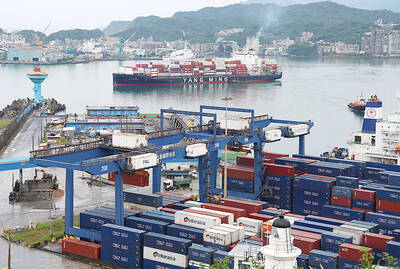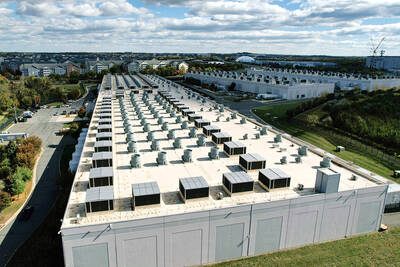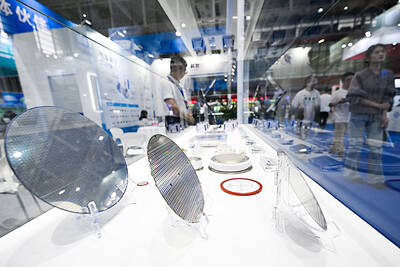CHIPMAKERS
UMC posts record revenue
United Microelectronics Co (UMC, 聯電), the world’s No. 3 contract chipmaker, yesterday reported record monthly revenue of NT$16.62 billion (US$584.66 million) for last month, up 14.06 percent from NT$14.57 billion a year earlier and 11.17 percent from NT$14.95 billion in February. In the first three months of this year, cumulative revenue grew 11.43 percent to NT$47.1 billion from NT$42.27 billion a year earlier, UMC said in a statement. Cumulative revenue grew 3.98 percent quarter-on-quarter, in line with the company’s forecast. Separately, Macronix International Co (旺宏電子), which supplies memory chips for Japanese gaming console maker Nintendo Co, yesterday reported that its revenue dropped 7.1 percent annually, but increased 19.8 percent monthly to NT$3.61 billion last month. The company said cumulative revenue in the first quarter was NT$9.63 billion, the best revenue for the first quarter on record.
ELECTRONICS
Yageo revenue doubles
Yageo Corp (國巨), the world’s third-largest supplier of passive components, yesterday said that its revenue more than doubled to NT$8.73 billion last month from NT$4.03 billion a year earlier and grew 24.6 percent from NT$7.01 billion in February. Yageo attributed the growth to an increase in the number of working days and healthy demand. Cumulative revenue in the first quarter soared 137 percent annually to NT$23.74 billion — the second-highest quarterly revenue in the company’s history, it said. Meanwhile, rival Walsin Technology Corp (華新科技) said that its revenue jumped 53.7 percent year-on-year and 25.7 percent month-on-month to NT$3.76 billion last month. Walsin said demand has increased due to a stay-at-home economy and cloud-computing devices. First-quarter revenue expanded 64.1 percent year-on-year to NT$10.46 billion from NT$6.37 billion.
MACHINERY
Parts makers beat forecasts
The performance of makers of industrial automation components beat market expectations last month, with linear-motion component suppliers, such as Hiwin Technologies Co (上銀科技), and pneumatic parts makers, such as Airtac International Group (亞德客), reporting record revenues. Hiwin yesterday posted revenue of NT$2.16 billion, up 15.79 percent month-on-month and 59.22 percent year-on-year, while Airtac’s revenue was NT$2.39 billion, up 69.34 percent month-on-month and 37.58 percent year-on-year, regulatory filings showed. In the first quarter, Hiwin’s revenue totaled NT$5.99 billion, up 65.8 percent from a year earlier and the highest for the January-to-March quarter, while Airtac’s revenue was NT$5.93 billion, up 87.89 percent and also a record.
PHARMACEUTICALS
EirGenix, Hong Wei ink pact
EirGenix Inc (台康生技) on Tuesday signed a letter of intent with Hong Wei Investment Co (鋐維股份) to sell 55 million new common shares via a private placement for NT$5.04 billion, the pharmaceuticals firm said in a statement. The deal would allow Hong Wei to secure an 18.56 percent stake in EirGenix and become the largest shareholder of the company, the statement said. EirGenix, a contract development and manufacturing organization and biosimilars maker, said that the deal is conducive to its long-term development as it would help enhance the company’s operating efficiency and bolster its competitiveness. The main shareholder of Hong Wei is Hon Hai Precision Industry Co (鴻海精密) founder Terry Gou (郭台銘).

Taiwan’s exports soared 56 percent year-on-year to an all-time high of US$64.05 billion last month, propelled by surging global demand for artificial intelligence (AI), high-performance computing and cloud service infrastructure, the Ministry of Finance said yesterday. Department of Statistics Director-General Beatrice Tsai (蔡美娜) called the figure an unexpected upside surprise, citing a wave of technology orders from overseas customers alongside the usual year-end shopping season for technology products. Growth is likely to remain strong this month, she said, projecting a 40 percent to 45 percent expansion on an annual basis. The outperformance could prompt the Directorate-General of Budget, Accounting and

The demise of the coal industry left the US’ Appalachian region in tatters, with lost jobs, spoiled water and countless kilometers of abandoned underground mines. Now entrepreneurs are eyeing the rural region with ambitious visions to rebuild its economy by converting old mines into solar power systems and data centers that could help fuel the increasing power demands of the artificial intelligence (AI) boom. One such project is underway by a non-profit team calling itself Energy DELTA (Discovery, Education, Learning and Technology Accelerator) Lab, which is looking to develop energy sources on about 26,305 hectares of old coal land in

Netflix on Friday faced fierce criticism over its blockbuster deal to acquire Warner Bros Discovery. The streaming giant is already viewed as a pariah in some Hollywood circles, largely due to its reluctance to release content in theaters and its disruption of traditional industry practices. As Netflix emerged as the likely winning bidder for Warner Bros — the studio behind Casablanca, the Harry Potter movies and Friends — Hollywood’s elite launched an aggressive campaign against the acquisition. Titanic director James Cameron called the buyout a “disaster,” while a group of prominent producers are lobbying US Congress to oppose the deal,

Two Chinese chipmakers are attracting strong retail investor demand, buoyed by industry peer Moore Threads Technology Co’s (摩爾線程) stellar debut. The retail portion of MetaX Integrated Circuits (Shanghai) Co’s (上海沐曦) upcoming initial public offering (IPO) was 2,986 times oversubscribed on Friday, according to a filing. Meanwhile, Beijing Onmicro Electronics Co (北京昂瑞微), which makes radio frequency chips, was 2,899 times oversubscribed on Friday, its filing showed. The bids coincided with Moore Threads’ trading debut, which surged 425 percent on Friday after raising 8 billion yuan (US$1.13 billion) on bets that the company could emerge as a viable local competitor to Nvidia